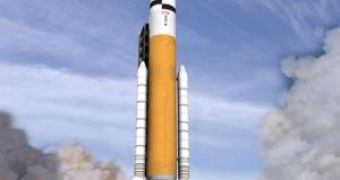A team of renowned scientists from the US National Research Council (NRC) were asked by NASA last year to assess which new missions would be better suited for their next-gen spacecraft built as a part of the Constellation program. The NRC report, called "Launching Science: Science Opportunities Provided by NASA's Constellation System", came up with a list of missions, while saluting the near-Earth object mission proposed by the Planetary Society, cautioned on the high cost of all potential missions.
NASA's mammoth rocket Ares V's first flight is slated for 2020. Upon completion, it will be capable to haul up in space very large (eight meters across) and heavy (55 tons) objects, up to a distance of 1.5 million kilometers away from the Earth, where L2 (where a number of missions aim to plant probes) lies.
Although the assessing committee advised NASA to give a thorough thought to the near-Earth Object mission that would provide "an intermediate step between lunar exploration and interplanetary travel," "it wasn't part of the criteria we were given," explained for New Scientist the group's co-chair, former shuttle astronaut Kathryn Thornton. Instead, they chose other five missions as more of a priority.
These include the eight-meter large Monolith Space Telescope which would make Hubble obsolete, an interstellar high speed probe that would sprint to the solar system's edges and study interstellar space in situ, a Neptune orbiter and atmospheric probe that would study the distant planet, with a separate probe for its Triton moon, and two solar probes: one that would orbit its poles closer than Venus, and another that would be tough enough to make it into the Sun's corona. The estimated prices for these missions vary between $1 billion and $5 billion.
Alan Stern, former NASA science chief, warned that NASA had already overrun the budget allocated for the James Webb Space Telescope and the Mars Science Laboratory, financially limiting the missions projected.

 14 DAY TRIAL //
14 DAY TRIAL //